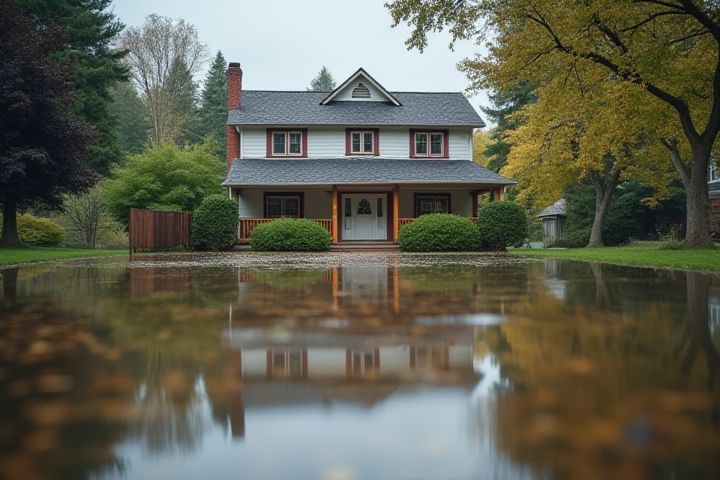
If your house floods, prioritize safety by evacuating immediately and moving to higher ground. Once safe, cut off electricity and gas to prevent electrical hazards and potential fires. Document the damage by taking photos or videos for insurance purposes, ensuring you capture all affected areas and belongings. Contact your insurance provider promptly to report the flood and begin the claims process. After securing safety and documenting the incident, start removing water and drying out the space to prevent mold growth, using pumps, wet vacuums, and fans as necessary.
What To Do If Your House Floods
Ensure personal safety
Prioritize your safety by immediately evacuating the flooded area, moving to higher ground if necessary. Turn off all electrical appliances and gas supply to prevent fires or explosions; do not attempt to retrieve valuables until it is safe. Keep emergency supplies, such as a flashlight and first-aid kit, easily accessible for when you return. Floodwaters can contain contaminants, so avoid direct contact with the water, and always follow local authorities' guidelines regarding re-entry into your home.
Turn off electricity
If your house floods, the first step is to prioritize safety by turning off the electricity at the main circuit breaker to prevent electrical hazards. Ensure you avoid standing water while accessing the breaker, as this can pose serious risks. After securing electricity, you should contact your utility provider to report the flooding and receive further instructions. Assess the damage once it's safe to do so, and document everything for insurance purposes.
Avoid using tap water
In the event of a flood, it's crucial to avoid using tap water for drinking, cooking, or hygiene, as it may be contaminated with harmful bacteria or pollutants. Instead, prioritize obtaining bottled water or water from a trusted source to ensure your safety and health. Thoroughly inspect your home for any structural damage, and document any losses for insurance claims. Always follow local advisories regarding water safety and restoration efforts to protect your household and community effectively.
Document damages
Documenting damages after a flood is crucial for insurance claims and recovery. Start by taking detailed photographs of affected areas, including structural damage, personal belongings, and appliances, ensuring you capture before and after each item. Note down the date and time of the flooding, and create a comprehensive list of lost or damaged items, assigning values to them whenever possible. This systematic approach will enhance your claim process and provide a clear record of the impact on your property.
Contact insurance
Contact your insurance provider immediately to report the flooding incident and start the claims process. Gather essential documentation, including photos of the damage and a detailed inventory of affected items, to facilitate your claim. Your policy may cover repairs, replacement of damaged personal property, and additional living expenses if your home is uninhabitable. Be aware of your coverage limits and any exclusions specific to flood damage, as this can significantly impact your compensation.
Salvage important items
To effectively handle a house flood, prioritize the salvage of important items such as documents, electronics, and family heirlooms. Quickly assess the areas that have been affected and identify items that are irreplaceable or hold sentimental value. Use waterproof containers if available to protect these items from further damage, and consider utilizing a wet-dry vacuum to remove excess water from the surroundings. Once you've salvaged essential items, ensure they are properly dried and cleaned to prevent mold or long-term damage.
Prevent mold growth
To effectively prevent mold growth after a house flood, initiate the drying process within 24 to 48 hours. Remove all water-logged materials, such as carpets, upholstery, and drywall, as they can harbor mold spores. Utilize dehumidifiers and fans to maintain indoor humidity levels below 50%, creating an environment unfavorable for mold. Regularly inspect hidden areas, such as behind appliances, for any signs of moisture accumulation that can contribute to mold development.
Clean and disinfect
After a house flood, promptly clean and disinfect all affected areas to prevent mold growth and bacteria proliferation. Start by removing standing water using pumps or buckets, and ensure proper ventilation by opening windows and using fans. Discard any contaminated items, such as carpets and upholstery, as they can harbor pathogens. Then, scrub surfaces with a mixture of detergent and water, followed by a solution of bleach or a commercial disinfectant to sanitize the area thoroughly.
Repair structure
When your house floods, the immediate focus should be on assessing and repairing the structural integrity. Begin by thoroughly inspecting the foundation, walls, and roof for any signs of damage or weakening caused by the water. It's crucial to remove all wet materials, including flooring and drywall, to prevent mold growth and further deterioration. Consult with a professional contractor to ensure that those repairs meet local building codes and enhance your home's resilience against future flooding.
Seek professional help
If your house floods, seeking professional help is crucial to minimize damage and ensure safety. Contact a certified water damage restoration service within 24-48 hours to prevent mold growth, which can begin within 24 hours of exposure. Additionally, local emergency services can assist with immediate hazards, especially if there are downed power lines or structural instability. Remember to document the damage with photos for insurance claims, ensuring you capture any visible water levels or damages to your property.
